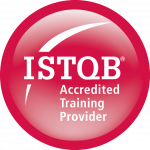Risk Based Testing
Stressing the importance of risk based testing and benefits that risk based testing can have in an organisation
Join a public online course, or study at your own pace with Distance Learning.
Course Booking Form
Distance Learning
Bespoke delivery at your workplace or online
Course Booking Form
Course Objectives
To provide a framework on how to apply a risk based testing approach, an understanding of approaches for consideration and managing the test process, the impact on the testing process. Highlighting the benefits and reporting impacts of risk based testing.
Who will benefit?
Test managers, team leaders, development mangers, project managers, QA managers, testers and anyone wishing to gain a practical insight into Risk Based testing.
Prerequisites
None. However, delegates would benefit from a little knowledge relating to risk and IT development.
Skills Gained
- Obtain a detailed understanding about risk and its application to testing
- Understanding approaches to risk assessment and vital areas to consider with choosing the approach
- Understand how to adopt a risk-based approach to testing
- Estimate, plan, monitor and control testing on a project underpinning risk approach
- Getting the best use of testing techniques
- How to avoid misunderstandings associated with risk based testing
Course Content
What is risk?
Describes the concept of risk and the differences between risk and an issue. Explains the different types of risks you can have and typical risks faced by testing on IT projects.
Principles of Risk Management Process
Introduces core activities of risk management, namely; risk identification, risk analysis and risk mitigation. Explains how testing can be effectively used in the process of risk management.
Risk Approaches
Explains the ways in which risk assessments can be conducted based upon critical success factors. Strengths/weaknesses to each approach are discussed and practical examples are undertaken.
Testing and Risk
Applying the information from the risk assessment into the testing levels and activities including production of the deliverables produced such as test planning, schedule (through estimation) test cases and reporting.
Test Planning
Knowing that there is never enough time to test, this section covers how to get the most of testing through good test planning and ensuring focus remains on the risks identified in the risk assessment. It will also detail principles of test estimation and its impact on progress and risks as well.
Test Techniques
Different techniques can be used at different levels of testing and some are more applicable to certain situations than others. This section describes the techniques available for use and their advantages/disadvantages. Some are more thorough than others and this is discussed using a risk matrix
Test Progress, Monitoring and Control
Discusses what should be monitored in testing, and what actions can be taken when actual figures diverge from the plan. Explains the powerful technique of S-curves as well as other monitoring techniques and actions that can be taken. Discusses how to gain control of the testing process.
Test Reporting
Testing provides information through reports for management to make that crucial decision whether or not to go-live & understand the risks associated with that decision. This section focuses on the different types of reports that can be produced for management to achieve that objective.
Action Plans
After understanding how to tackle misunderstandings about Risk Based testing and based upon vital areas for consideration when choosing an approach, creating an action plan on how to implement risk based testing into the organisation.



